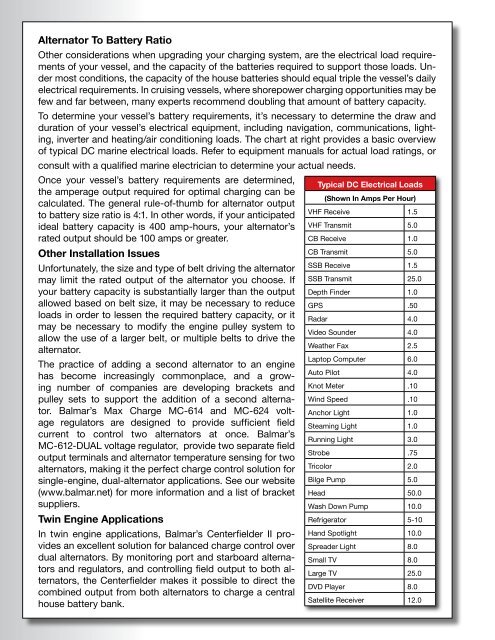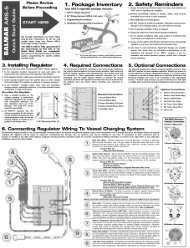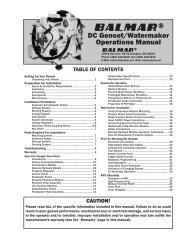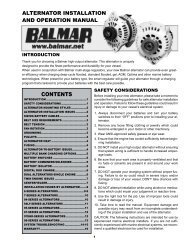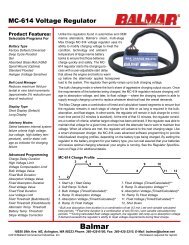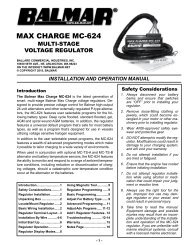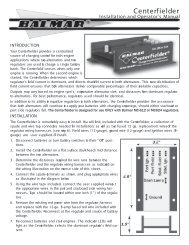Balmar Product Guide - Boat Electric
Balmar Product Guide - Boat Electric
Balmar Product Guide - Boat Electric
You also want an ePaper? Increase the reach of your titles
YUMPU automatically turns print PDFs into web optimized ePapers that Google loves.
Alternator To Battery Ratio<br />
Other considerations when upgrading your charging system, are the electrical load requirements<br />
of your vessel, and the capacity of the batteries required to support those loads. Under<br />
most conditions, the capacity of the house batteries should equal triple the vessel’s daily<br />
electrical requirements. In cruising vessels, where shorepower charging opportunities may be<br />
few and far between, many experts recommend doubling that amount of battery capacity.<br />
To determine your vessel’s battery requirements, it’s necessary to determine the draw and<br />
duration of your vessel’s electrical equipment, including navigation, communications, lighting,<br />
inverter and heating/air conditioning loads. The chart at right provides a basic overview<br />
of typical DC marine electrical loads. Refer to equipment manuals for actual load ratings, or<br />
consult with a qualified marine electrician to determine your actual needs.<br />
Once your vessel’s battery requirements are determined,<br />
Typical DC <strong>Electric</strong>al Loads<br />
the amperage output required for optimal charging can be<br />
(Shown In Amps Per Hour)<br />
calculated. The general rule-of-thumb for alternator output<br />
to battery size ratio is 4:1. In other words, if your anticipated<br />
VHF Receive 1.5<br />
ideal battery capacity is 400 amp-hours, your alternator’s VHF Transmit 5.0<br />
rated output should be 100 amps or greater.<br />
CB Receive 1.0<br />
Other Installation Issues<br />
CB Transmit 5.0<br />
Unfortunately, the size and type of belt driving the alternator<br />
SSB Receive 1.5<br />
may limit the rated output of the alternator you choose. If SSB Transmit 25.0<br />
your battery capacity is substantially larger than the output Depth Finder 1.0<br />
allowed based on belt size, it may be necessary to reduce GPS .50<br />
loads in order to lessen the required battery capacity, or it<br />
Radar 4.0<br />
may be necessary to modify the engine pulley system to<br />
Video Sounder 4.0<br />
allow the use of a larger belt, or multiple belts to drive the<br />
Weather Fax 2.5<br />
alternator.<br />
The practice of adding a second alternator to an engine<br />
Laptop Computer 6.0<br />
has become increasingly commonplace, and a growing<br />
Auto Pilot 4.0<br />
number of companies are developing brackets and Knot Meter .10<br />
pulley sets to support the addition of a second alternator.<br />
Wind Speed .10<br />
<strong>Balmar</strong>’s Max Charge MC-614 and MC-624 volt-<br />
Anchor Light 1.0<br />
age regulators are designed to provide sufficient field Steaming Light 1.0<br />
current to control two alternators at once. <strong>Balmar</strong>’s<br />
Running Light 3.0<br />
MC-612-DUAL voltage regulator, provide two separate field<br />
Strobe .75<br />
output terminals and alternator temperature sensing for two<br />
alternators, making it the perfect charge control solution for<br />
Tricolor 2.0<br />
single-engine, dual-alternator applications. See our website Bilge Pump 5.0<br />
(www.balmar.net) for more information and a list of bracket Head 50.0<br />
suppliers.<br />
Wash Down Pump 10.0<br />
Twin Engine Applications<br />
Refrigerator 5-10<br />
In twin engine applications, <strong>Balmar</strong>’s Centerfielder II provides<br />
Hand Spotlight 10.0<br />
an excellent solution for balanced charge control over Spreader Light 8.0<br />
dual alternators. By monitoring port and starboard alternators<br />
Small TV 8.0<br />
and regulators, and controlling field output to both al-<br />
Large TV 25.0<br />
ternators, the Centerfielder makes it possible to direct the<br />
DVD Player 8.0<br />
combined output from both alternators to charge a central<br />
Satellite Receiver 12.0<br />
house battery bank.


